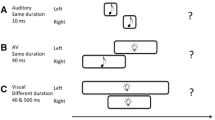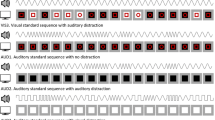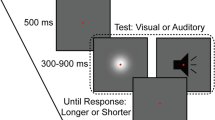Abstract
Auditory stimuli usually have longer subjective durations than visual ones for the same real duration, although performance on many timing tasks is similar in form with different modalities. One suggestion is that auditory and visual stimuli are initially timed by different mechanisms, but later converted into some common duration code which is amodal. The present study investigated this using a temporal generalization interference paradigm. In test blocks, people decided whether comparison durations were or were not a 400-ms standard on average. Test blocks alternated with interference blocks where durations were systematically shorter or longer than in test blocks, and interference was found, in the direction of the durations in the interference blocks, even when the interfering blocks used stimuli in a different modality from the test block. This provides what may be the first direct experimental evidence for a “common code” for durations initially presented in different modalities at some level of the human timing system.


Similar content being viewed by others
References
Droit-Volet, S., Tourret, S., & Wearden, J. (2004). Perception of the duration of auditory and visual stimuli in children and adults. Quarterly Journal of Experimental Psychology, 57, 797–818.
Fortin, C., & Breton, R. (1995). Temporal interval production and processing in working memory. Perception and Psychophysics, 57, 203–215.
Goldstone, S., & Lhamon, W. T. (1974). Studies of auditory–visual differences in duration judgment: 1. Sounds are judged longer than lights. Perceptual and Motor Skills, 39, 63–82.
Grondin, S. (2005). Overloading temporal memory. Journal of Experimental Psychology: Human Perception and Performance, 31, 869–879.
Guyau, J. M. (1890). La genèse de l’idée du temps. Paris: Alcan.
Hartshorne, J. K. (2008). Visual working memory capacity and proactive interference. PLoS ONE, 3(7), e2716.
Jones, L. A., Poliakoff, E., & Wells, J. (2009). Good vibrations: Human interval timing in the vibrotactile modality. Quarterly Journal of Experimental Psychology, 62, 2171–2186.
Jones, L. A., & Wearden, J. H. (2003). More is not necessarily better: Examining the nature of the temporal reference memory component in timing. Quarterly Journal of Experimental Psychology, 56, 321–343.
Jones, L. A., & Wearden, J. H. (2004). Double standards: Memory loading in temporal reference memory. Quarterly Journal of Experimental Psychology, 57B, 55–77.
Lejeune, H., & Wearden, J. H. (2009). Vierordt’s “The Experimental Study of the Time Sense” (1868) and its legacy. European Journal of Cognitive Psychology, 21, 941–960.
Ogden, R. S., Wearden, J. H., & Jones, L. A. (2008). The remembrance of times past: Interference in temporal reference memory. Journal of Experimental Psychology: Human Perception and Performance, 34, 1524–1544.
Penney, T. B., Gibbon, J., & Meck, W. H. (2000). Differential effects of auditory and visual signals on clock speed and temporal memory. Journal of Experimental Psychology: Human Perception and Performance, 26, 1770–1787.
Penton-Voak, I. S., Edwards, H., Percival, A., & Wearden, J. H. (1996). Speeding up an internal clock in humans? Effects of click trains on subjective duration. Journal of Experimental Psychology: Animal Behavior Processes, 22, 307–320.
Stauffer, C. C., Haldemann, J., Troche, S. J., & Rammsayer, T. H. (2012). Auditory and visual temporal sensitivity: Evidence for a hierarchical structure of modality-specific and modality-independent levels of temporal information processing. Psychological Research, 76, 20–31.
Underwood, B. J. (1957). Interference and forgetting. Psychological Review, 64, 49–60.
Wearden, J. H. (1992). Temporal generalization in humans. Journal of Experimental Psychology: Animal Behavior Processes, 18, 134–144.
Wearden, J. H., & Bray, S. (2001). Scalar timing without reference memory: Episodic temporal generalization and bisection in humans. Quarterly Journal of Experimental Psychology, 54B, 289–310.
Wearden, J. H., Denovan, L., Fakhri, M., & Haworth, R. (1997). Scalar timing in temporal generalization in humans with longer stimulus durations. Journal of Experimental Psychology: Animal Behavior Processes, 23, 502–511.
Wearden, J. H., Edwards, H., Fakhri, M., & Percival, A. (1998). Why “sounds are judged longer than lights”: Application of a model of the internal clock in humans. Quarterly Journal of Experimental Psychology, 51B, 97–120.
Wearden, J. H., Norton, R., Martin, S., & Montford-Bebb, O. (2007). Internal clock processes and the filled duration illusion. Journal of Experimental Psychology: Human Perception and Performance, 33, 716–729.
Wearden, J. H., O’Rourke, S. C., Matchwick, C., Zhang, M., & Maeers, S. (2010). Task switching and subjective duration. Quarterly Journal of Experimental Psychology, 63, 531–543.
Wearden, J. H., Todd, N. P. M., & Jones, L. A. (2006). When do auditory/visual differences in duration judgements occur? Quarterly Journal of Experimental Psychology, 59, 1709–1724.
Author information
Authors and Affiliations
Corresponding author
Rights and permissions
About this article
Cite this article
Filippopoulos, P.C., Hallworth, P., Lee, S. et al. Interference between auditory and visual duration judgements suggests a common code for time. Psychological Research 77, 708–715 (2013). https://doi.org/10.1007/s00426-012-0464-6
Received:
Accepted:
Published:
Issue Date:
DOI: https://doi.org/10.1007/s00426-012-0464-6




